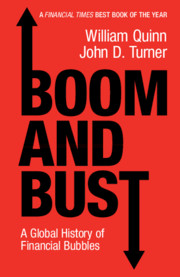Book contents
- Boom and Bust
- Boom and Bust
- Copyright page
- Contents
- Figures
- Tables
- Chapter 1 The Bubble Triangle
- Chapter 2 1720 and the Invention of the Bubble
- Chapter 3 Marketability Revived: The First Emerging Market Bubble
- Chapter 4 Democratising Speculation: The Great Railway Mania
- Chapter 5 Other People’s Money: The Australian Land Boom
- Chapter 6 Wheeler-Dealers: The British Bicycle Mania
- Chapter 7 The Roaring Twenties and the Wall Street Crash
- Chapter 8 Blowing Bubbles for Political Purposes: Japan in the 1980s
- Chapter 9 The Dot-Com Bubble
- Chapter 10 ‘No More Boom and Bust’: The Subprime Bubble
- Chapter 11 Casino Capitalism with Chinese Characteristics
- Chapter 12 Predicting Bubbles
- Acknowledgements
- Notes
- Bibliography
- Index
Chapter 12 - Predicting Bubbles
Published online by Cambridge University Press: 06 August 2020
- Boom and Bust
- Boom and Bust
- Copyright page
- Contents
- Figures
- Tables
- Chapter 1 The Bubble Triangle
- Chapter 2 1720 and the Invention of the Bubble
- Chapter 3 Marketability Revived: The First Emerging Market Bubble
- Chapter 4 Democratising Speculation: The Great Railway Mania
- Chapter 5 Other People’s Money: The Australian Land Boom
- Chapter 6 Wheeler-Dealers: The British Bicycle Mania
- Chapter 7 The Roaring Twenties and the Wall Street Crash
- Chapter 8 Blowing Bubbles for Political Purposes: Japan in the 1980s
- Chapter 9 The Dot-Com Bubble
- Chapter 10 ‘No More Boom and Bust’: The Subprime Bubble
- Chapter 11 Casino Capitalism with Chinese Characteristics
- Chapter 12 Predicting Bubbles
- Acknowledgements
- Notes
- Bibliography
- Index
Summary
Chapter 12 is the conclusion of the book. The chapter starts by arguing that the bubble triangle can explain why the cryptocurrency bubble occurred in 2017. It then asks whether the bubble triangle is a good predictive tool. The answer to that question is yes, but bubbles are still difficult to predict because the sparks are difficult to discern. The bubble triangle is also able to predict which bubbles will be destructive (politically sparked bubbles with high bank lending) and which will be useful (technology sparked bubbles with low leverage). The chapter then moves on to look at what governments could do to prevent bubbles. However, since political bubbles are often created because they are in the government’s interest, governments cannot be relied upon to take these measures. The question then arises as to whether the news media can alert investors to the presence of bubbles. The answer to this question very much depends on whether they have the incentive to do so, and this incentive appears to be diminishing over time. The chapter concludes by arguing that investors need to build broad mental models, which include history, if they are to have any chance of predicting bubbles.
Keywords
Information
- Type
- Chapter
- Information
- Boom and BustA Global History of Financial Bubbles, pp. 210 - 222Publisher: Cambridge University PressPrint publication year: 2020
